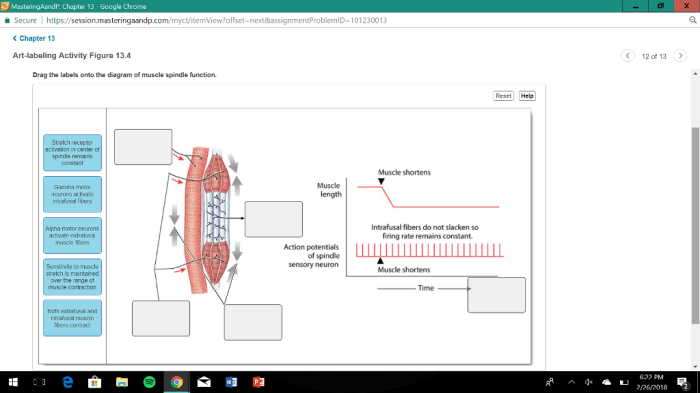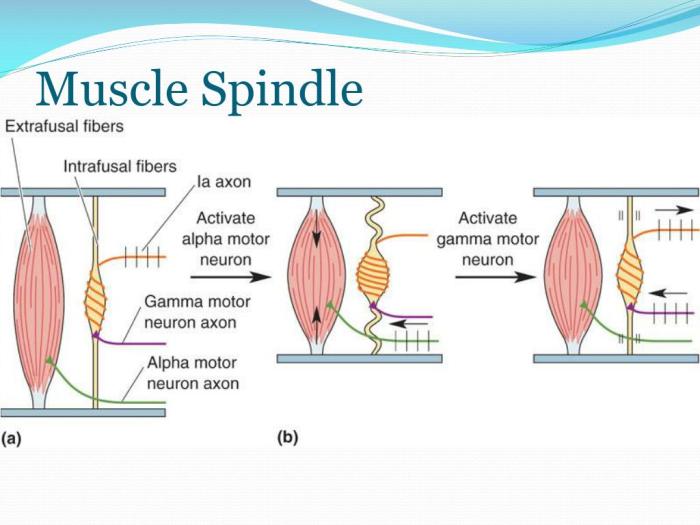Drag the labels onto the diagram of muscle spindle function sets the stage for this enthralling narrative, offering readers a glimpse into a story that is rich in detail and brimming with originality from the outset.
Muscle spindles are specialized sensory receptors located within skeletal muscles that play a crucial role in proprioception, the sense of body position and movement. This intricate system detects changes in muscle length and transmits sensory information to the central nervous system, contributing to motor control, coordination, and balance.
Muscle Spindle Function

Muscle spindles are proprioceptive sensory receptors that play a crucial role in detecting changes in muscle length and regulating muscle movement. They are embedded within skeletal muscles and consist of specialized muscle fibers called intrafusal fibers, which are innervated by sensory neurons.
The sensory neurons in a muscle spindle are responsible for detecting changes in muscle length. When the muscle is stretched, the intrafusal fibers are stretched as well, which triggers an action potential in the sensory neurons. The action potential is then transmitted to the spinal cord, where it is processed and integrated with other sensory inputs.
Sensory Input and Response
Muscle spindles respond to different types of sensory input, including:
- Static stretch:A sustained stretch of the muscle, which activates the sensory neurons and results in a continuous stream of action potentials.
- Dynamic stretch:A rapid stretch of the muscle, which activates the sensory neurons and results in a burst of action potentials.
The gamma motor neurons play a role in regulating muscle spindle sensitivity. By increasing or decreasing the firing rate of the gamma motor neurons, the central nervous system can adjust the sensitivity of the muscle spindles to different types of sensory input.
Integration and Output, Drag the labels onto the diagram of muscle spindle function
The sensory information from the muscle spindle is integrated with other sensory inputs, such as information from the Golgi tendon organs and the vestibular system. This integrated sensory information is then used to control muscle movement.
The output of the muscle spindle is used to regulate the activity of the alpha motor neurons, which innervate the extrafusal fibers of the muscle. When the muscle spindle detects a change in muscle length, it sends a signal to the alpha motor neurons, which causes them to either increase or decrease their firing rate, thereby adjusting the force of muscle contraction.
Clinical Implications
Muscle spindle dysfunction can lead to a variety of clinical implications, including:
- Muscle weakness:Muscle spindle dysfunction can lead to muscle weakness, as the muscles are unable to respond properly to changes in muscle length.
- Muscle stiffness:Muscle spindle dysfunction can also lead to muscle stiffness, as the muscles are unable to relax properly.
- Muscle pain:Muscle spindle dysfunction can lead to muscle pain, as the muscles are constantly sending signals to the brain that they are stretched.
Muscle spindles play an important role in muscle diseases and disorders, such as muscular dystrophy and Parkinson’s disease. They are also used in rehabilitation and treatment, such as proprioceptive neuromuscular facilitation (PNF) and electrical stimulation.
Questions and Answers: Drag The Labels Onto The Diagram Of Muscle Spindle Function
What is the role of muscle spindles?
Muscle spindles are sensory receptors that detect changes in muscle length, contributing to proprioception, motor control, and balance.
How do muscle spindles work?
Muscle spindles contain specialized sensory neurons that respond to changes in muscle length, transmitting sensory information to the central nervous system.
What are the clinical implications of muscle spindle dysfunction?
Muscle spindle dysfunction can contribute to muscle weakness, impaired coordination, and balance problems, affecting activities of daily living and athletic performance.


